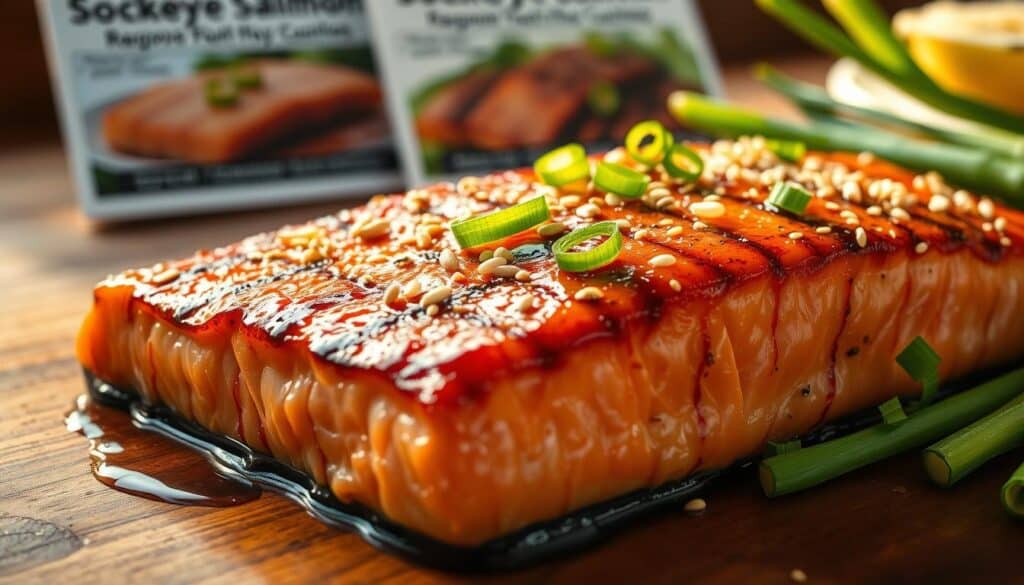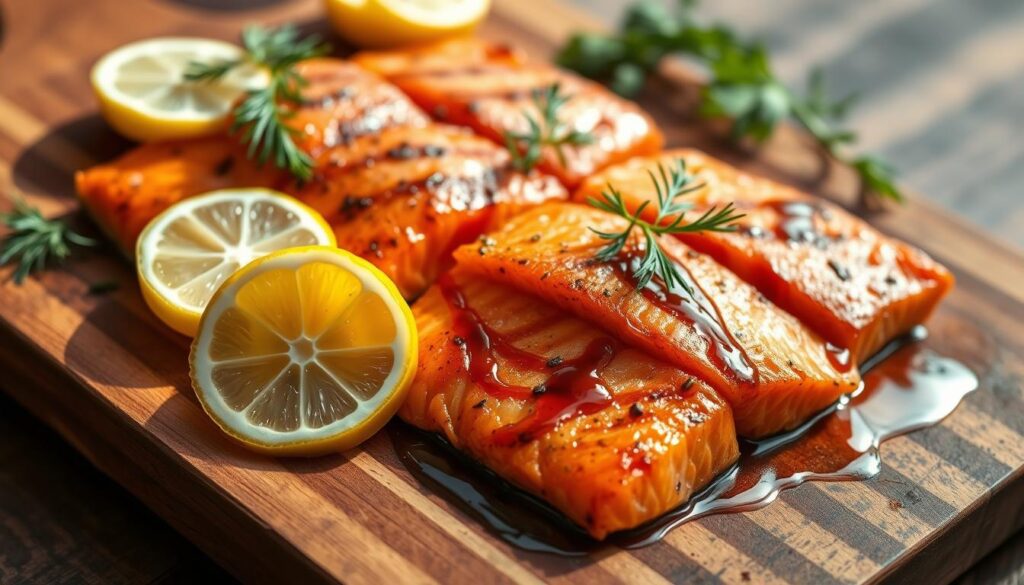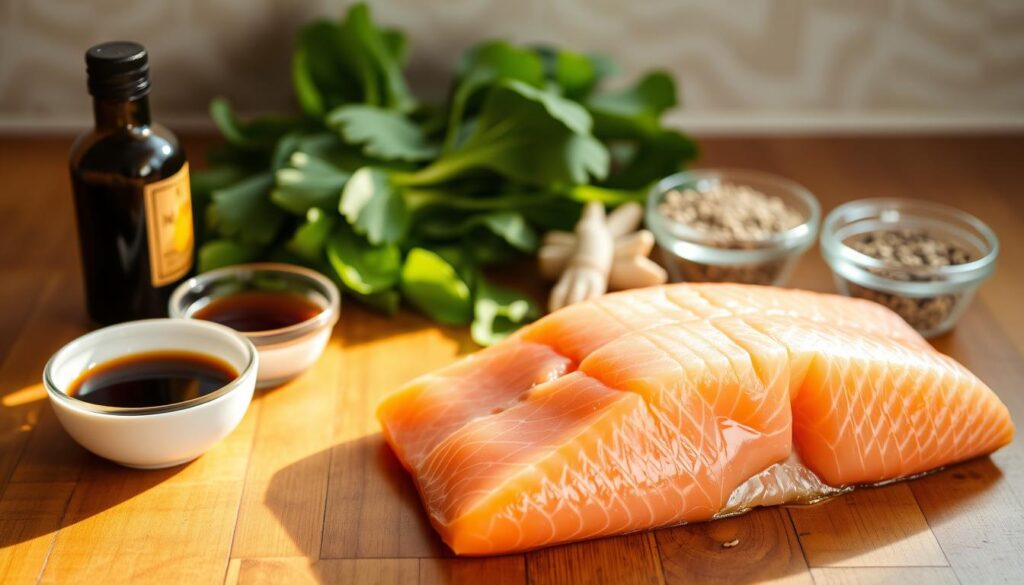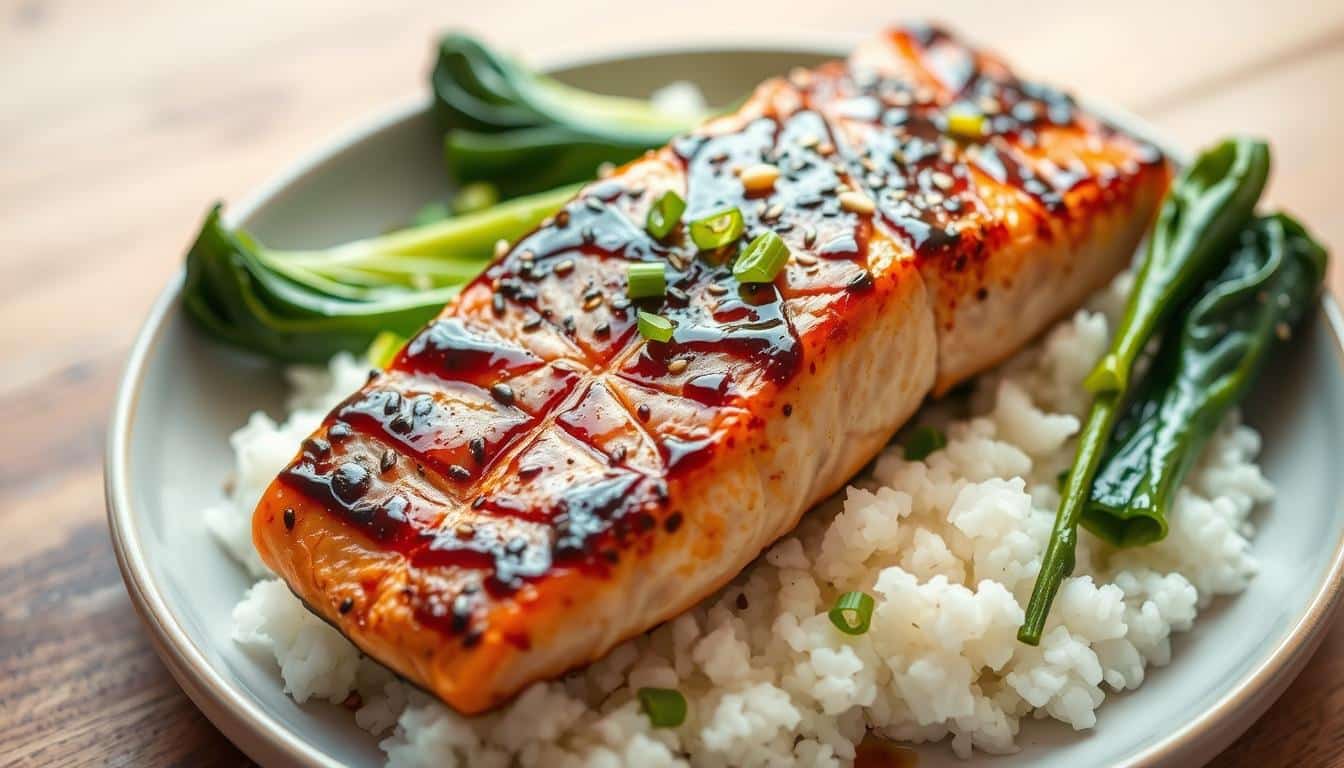Looking for a tasty and healthy dinner that’s quick to make? You’re in luck! This simple and flavorful dish is ready in just 15 minutes!
To make this mouth-watering miso-glazed salmon, you’ll need a few ingredients. You’ll need 4 salmon fillets (6 oz each), 1/4 cup of miso paste, 2 tbsp of soy sauce, 2 tbsp of brown sugar, 2 tbsp of rice vinegar, and 1 tsp of grated ginger.
This easy dinner recipe is great for busy weeknights. You can get a nutritious meal on the table quickly. The mix of miso paste, soy sauce, and ginger makes a rich glaze that goes well with the salmon.
Table of Contents
Key Takeaways
- Quick and easy dinner recipe ready in 15 minutes
- Delicious miso-glazed salmon fillets
- Simple ingredients: miso paste, soy sauce, brown sugar, rice vinegar, and ginger
- Perfect for busy weeknights
- Healthy and nutritious meal option
The Magic of Miso Salmon
Miso salmon is a quick and healthy dinner option. It mixes the health benefits of salmon with the savory taste of miso paste. This creates a meal that’s both tasty and good for you.
What Makes Miso Salmon Special
Miso salmon is special because of its unique flavor profile and nutritional benefits. The miso paste brings a deep umami flavor that goes well with the salmon. This makes the dish both complex and delicious.
Health Benefits of This Dish
Salmon, like sockeye, is full of omega-3 fatty acids. These are good for your heart and brain. When you learn how to cook sockeye salmon with miso, you get a nutritious meal. Sockeye salmon recipes show off the fish’s natural taste, and with miso, it becomes even healthier and tastier.

Understanding Sockeye Salmon for Your Recipe
Sockeye salmon is perfect for your miso salmon recipe. It has a deep red color and firm texture. This makes your dish look great and taste amazing with the savory miso glaze.
Nutritional Benefits of Sockeye Salmon
Sockeye salmon is full of nutrients, making it a healthy choice. It’s rich in protein and omega-3 fatty acids. These are good for your heart and brain.
It also has lots of vitamin D and selenium. These nutrients offer many health benefits.

Why Sockeye Works Well with Miso
The firm texture and rich flavor of sockeye salmon pair well with miso. The miso paste adds a deep umami flavor. This balances the natural oils in the salmon, creating a delicious taste.
Choosing sockeye salmon for your miso salmon recipe is a smart choice. It’s both tasty and nutritious. Sockeye salmon is a great option for a healthy and flavorful meal.
Essential Ingredients for Miso Salmon Recipe
To make miso salmon, you need fresh and tasty ingredients. You’ll gather a few key items. These ingredients work together to enhance the flavors.
The Salmon
The main ingredient is the salmon. You’ll need high-quality Sockeye salmon fillets for this recipe.
Quantity: 4 Sockeye Salmon Fillets (6 oz each)
Choose salmon that’s firm and has a bright color.
How to Select Fresh Salmon
Make sure the salmon smells like the ocean. It should be stored on ice.
The Miso Paste
Miso paste is key to the dish’s flavor.
Quantity: 3 Tablespoons White Miso Paste
Use white miso paste for its mild, sweet taste.
Supporting Ingredients
Other ingredients add to the dish’s flavor.
Sweeteners: 2 Tablespoons Mirin, 1 Tablespoon Honey
Mirin and honey balance the savory flavors with sweetness.
Aromatics: 1 Tablespoon Grated Ginger, 2 Cloves Minced Garlic
Ginger and garlic add a fragrant aroma that goes well with the salmon.
Additional Flavorings: 2 Tablespoons Soy Sauce, 1 Teaspoon Sesame Oil
Soy sauce and sesame oil bring depth and a nutty flavor.
| Ingredient | Quantity |
|---|---|
| Sockeye Salmon Fillets | 4 fillets (6 oz each) |
| White Miso Paste | 3 Tablespoons |
| Mirin | 2 Tablespoons |
| Honey | 1 Tablespoon |
| Ginger | 1 Tablespoon (grated) |
| Garlic | 2 Cloves (minced) |
| Soy Sauce | 2 Tablespoons |
| Sesame Oil | 1 Teaspoon |

Kitchen Tools You’ll Need
Having the right kitchen tools is key for a stress-free miso salmon cooking experience. You’ll need a few important items to prepare your miso salmon.
Essential Equipment
You’ll need a heavy baking sheet lined with aluminum foil for even cooking and easy cleanup. A metal spatula is also crucial for gently flipping and serving the salmon. Don’t forget a cutting board for preparing the salmon and any other ingredients.
Optional but Helpful Tools
While not essential, some tools can make cooking easier. A marinade brush helps coat the salmon evenly with the miso marinade. A meat thermometer ensures your salmon is cooked to the perfect temperature, which is important for food safety.
Preparing Your Miso Salmon
The secret to a delicious miso salmon dish is in its preparation. Good preparation boosts the flavor and makes sure the salmon is cooked just right.
Cleaning and Portioning the Salmon
Start by rinsing the salmon fillets under cold water. Then, dry them with paper towels. This removes any dirt and helps the marinade stick better. Next, cut the salmon into the right sizes for serving. This makes it easier to marinate and cook evenly.
Creating the Perfect Miso Marinade
To marinate the salmon, you need a miso marinade. Mix miso paste with mirin, soy sauce, and sake. This creates a tasty sauce. Start with equal parts miso paste and mirin for a good flavor.
Marinating Techniques and Timing
After making your marinade, coat the salmon fillets evenly. Make sure they’re fully covered. Put the coated salmon in a sealed container and chill it. The marinating time can be 30 minutes, a few hours, or even overnight, depending on how strong you like the flavor.
By following these steps, you’ll make delicious miso salmon that’s packed with flavor.
How to Cook Sockeye Salmon
To cook sockeye salmon right, knowing the optimal cooking temperature is key. It’s all about finding the right balance of heat and time. This keeps the salmon’s flavor rich and its texture firm.
Optimal Cooking Temperature
The best temperature for cooking sockeye salmon is between 400°F to 425°F (200°C to 218°C). Make sure your oven is preheated to 425°F (218°C) for baking.
How Long to Cook Sockeye Salmon
The cooking time depends on the salmon’s thickness and the method used. Baking it in a preheated oven at 425°F (218°C) usually takes 12-15 minutes.
Testing for Doneness
To check if your sockeye salmon is cooked just right, use a thermometer. It should read 125-130°F (52-54°C). You can also flake the salmon with a fork. It should flake easily but still be moist.
Avoiding Common Cooking Mistakes
Don’t overcook the salmon. Keep an eye on the time and use a thermometer. Also, don’t overcrowd the baking sheet. This can cause uneven cooking.
| Cooking Method | Temperature | Cooking Time |
|---|---|---|
| Baking | 425°F (218°C) | 12-15 minutes |
| Grilling | Medium-High Heat | 4-6 minutes per side |
| Pan-Searing | Medium Heat | 3-4 minutes per side |
Miso Salmon Recipe: Step-by-Step Instructions
Making miso salmon at home is easier than you think. It starts with preparing the marinade. The marinade gives the salmon its flavor and tender texture.
Preparing the Marinade
To make the marinade, mix several ingredients together in the right order. Start by whisking together miso paste, mirin, soy sauce, and sake in a bowl.
Mixing Ingredients in the Correct Order
Begin with the miso paste, whisking it until it’s smooth. Then, add mirin, soy sauce, and sake. Whisk continuously to mix well.
Achieving the Perfect Consistency
The marinade should be smooth and thick. If it’s too thick, add a little water. If it’s too thin, simmer it to reduce it.
Marinating the Salmon
Once the marinade is ready, coat the salmon fillets. Proper coating ensures even flavor.
Proper Coating Techniques
Place the salmon fillets in a shallow dish. Brush the marinade evenly over both sides of the fish. Make sure the salmon is fully coated.
Ideal Marinating Time
The salmon should marinate for at least 1-2 hours in the refrigerator. The longer it marinates, the more flavorful it will be.
Cooking the Salmon
After marinating, cook the salmon. Start by preheating your cooking surface, whether it’s a skillet or grill.
Preheating Your Cooking Surface
Heat the skillet or grill over medium-high heat. For a skillet, add a small amount of oil to prevent sticking.
Proper Placement and Timing
Place the salmon fillets on the preheated surface, skin side down if they have skin. Cook for 3-4 minutes on the first side, then flip and cook for another 3-4 minutes, or until cooked through.
By following these step-by-step instructions, you’ll be able to create a delicious miso salmon dish that’s sure to impress.
Baked Sockeye Salmon Recipe
To make perfectly baked sockeye salmon, just follow these easy steps. Baking this fish is a healthy and tasty way to enjoy it.
Oven Preparation and Temperature
First, preheat your oven to the right temperature. Set it to 425°F (218°C). This high heat keeps the salmon moist and flavorful.
Step-by-Step Baking Instructions
After preheating, put the salmon on a baking sheet. Use parchment paper or foil, leaving space between each fillet. Bake for 12-15 minutes, depending on the fillet’s thickness and your desired doneness.
How to Tell When Baked Salmon is Done
To know if the salmon is cooked right, check the internal temperature. It should be 125-130°F (52-54°C). You can also flake it with a fork; it should flake easily but still be moist.
Finishing Touches for Perfect Baked Salmon
Once baked, let the salmon rest for a few minutes. This makes it tender and flavorful. Then, add herbs, lemon wedges, or sauces to enhance the taste and look.
By following these steps, you’ll make a delicious baked sockeye salmon dish. It’s sure to impress. The right oven prep, baking, and attention to doneness make for a perfect meal.
Delicious Side Dishes to Pair with Your Miso Salmon
Make your miso salmon even better with tasty side dishes. These can enhance its flavors and add variety to your meal. Try pairing it with traditional Japanese sides, quick veggies, or grains and noodles for a complete dining experience.
Traditional Japanese Accompaniments
For a true Japanese meal, serve your miso salmon with steamed Japanese rice, miso soup, and stir-fried vegetables. Bok choy or shiitake mushrooms are great choices. These classic sides bring out the best in miso salmon without overwhelming it.
Quick Vegetable Sides
Quick vegetable sides can brighten up your meal. Try grilled asparagus with lemon or a simple stir-fry with bell peppers, carrots, and snap peas. They add color and freshness.
Grain and Noodle Pairings
Grains and noodles offer a hearty base for your meal. Soba noodles or udon noodles with light soy sauce are perfect. Or, a quinoa salad with cucumber, cherry tomatoes, and sesame oil is a refreshing option.
| Side Dish | Description |
|---|---|
| Steamed Japanese Rice | A traditional and simple accompaniment that pairs well with miso salmon. |
| Miso Soup | A comforting soup that complements the flavors of miso salmon. |
| Grilled Asparagus | A quick and healthy vegetable side that adds freshness to the meal. |
Variations on the Classic Miso Salmon
Miso salmon is very versatile. You can make many different versions to match your taste. Just by adding different ingredients and flavors, you can turn this classic dish into something new and exciting.
Spicy Miso Salmon
Want a little heat? Try adding sriracha or red pepper flakes to the marinade. This gives your miso salmon a bold, spicy kick that goes well with the rich salmon flavor.
Citrus Miso Salmon
Adding citrus zest or juice to the marinade brings a bright, citrusy taste. This version is great for those who prefer a lighter, fresher take on the classic recipe.
Maple-Miso Salmon
For a sweeter twist, mix maple syrup into the miso marinade. This creates a rich, savory-sweet flavor that’s sure to impress.
| Variation | Key Ingredient | Flavor Profile |
|---|---|---|
| Spicy Miso Salmon | Sriracha or Red Pepper Flakes | Spicy, Bold |
| Citrus Miso Salmon | Citrus Zest or Juice | Bright, Citrusy |
| Maple-Miso Salmon | Maple Syrup | Sweet, Savory |
Storing and Reheating Leftover Miso Salmon
Don’t let your delicious miso salmon go to waste. Learn how to store and reheat it right. This way, you can enjoy it again without losing its taste or safety.
Proper Storage Methods
To keep your leftover miso salmon fresh, store it in an airtight container in the fridge. This keeps moisture and other flavors away. You can safely store it for up to 3 days.
Best Reheating Techniques
When reheating, use gentle heat to prevent drying out the salmon. You can reheat it in the microwave or in the oven at a low temperature. Make sure it’s heated through but not overcooked.
Creative Ways to Use Leftovers
Leftover miso salmon can be used in many dishes. Try flaking it into a salad, mixing it with rice, or as a topping for noodles. There are endless possibilities, and it’s a great way to reduce food waste.
Conclusion
You now have a simple and delicious miso salmon recipe for your weeknight dinners. It combines the rich flavor of sockeye salmon with the savory taste of miso paste. This creates a meal that’s both healthy and satisfying.
By following the steps in this article, you can make a mouth-watering miso salmon recipe. It’s sure to become a family favorite. The recipe is easy and flexible, perfect for busy evenings. Plus, you can store leftovers and reheat them for future meals.
With this miso salmon recipe, you can enjoy a restaurant-quality dish at home. Try different variations, like spicy or citrus miso salmon, to keep your meals exciting and varied.

